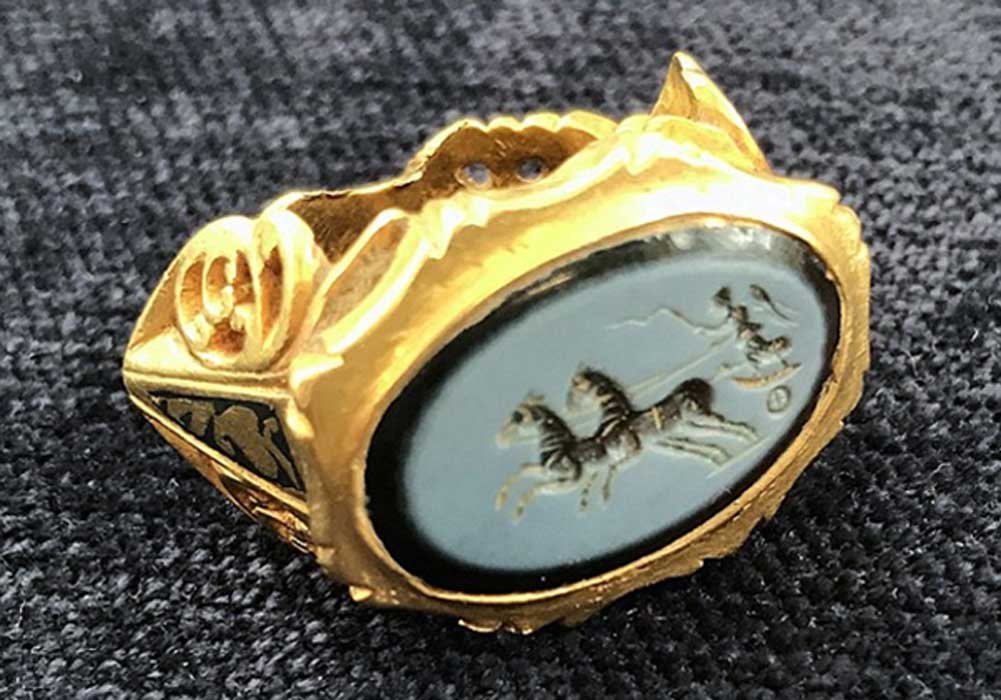An ‘Absolutely Stunning’ Roman Gold Ring Is Unearthed In England
An amateur treasure hunter has made a ‘stunning’ find from the Roman era in the south-west of England. With the help of a metal detector, the man discovered a golden ring at a site being investigated by local archaeologists. The find is being hailed as very important and one of the most significant finds from the Roman-era in the area in recent years. This discovery has kindled a new excitement regarding the importance of the location where it was discovered and illustrates once again the significant role amateur archaeologists play in unearthing the past.
Romans in Britain
The Romans first invaded Britain in 55 BC but only really tried to conquer it in 43 AD during the reign of Emperor Claudius. They managed to subdue the local Celtic tribes by 80 AD and they transformed local society. Rome built cities and roads and Romanized large swathes of the population during their occupation. Britain from the mid-3 rd century onwards was frequently attacked by barbarian tribes, and in 410 AD the Roman Emperor withdrew the last of the Roman legions from the province that was, over time, occupied mainly by the Anglo-Saxons. The most well-known Roman settlements in the area near the find are Bath and Dorchester, although the ring has been found far from both of these centers.
- Finders of Killingholme Treasure Hoard Make a Mint
- The Hoxne Hoard: How a Mislaid Hammer Led to the Largest Roman Treasure in Britain
- Heavy Hitters: 2,000-Year-Old Boxing Gloves Suggest Roman Soldiers Used to Duke It Out

The ring is large and of solid gold with an onyx stone engraved with the god ‘Victory’. (Image: BBC Somerset)
The find in a field
The find was made by Jason Massey, a full-time pest-control officer. He is an enthusiastic detectorist, that is someone who looks for artifacts of archaeological significance using a metal detector. Mr. Massey is a British army veteran and was taking part in a charitable event, organized by the ‘ Detecting for Veterans Group’, reports the Daily Mail.
Massey and the other members of the group went searching for artifacts at a location in Crewkerne, to the south of Yeovil in the County of Somerset. This site is believed to be a ‘very high-status villa complex’ according to the Daily Mail and is being investigated by the Somerset Archaeology Team.
The group of metal detector enthusiasts was invited to help in the investigation of the site. In a single day the group of detectorists unearthed almost 60 coins dating from the Roman-era, at the location. The majority of them are bronze coins, which are often found by amateur archaeologists all over England.
- Built to Last: The Secret that Enabled Roman Roads to Withstand the Passage of Time
- The translation of the Gallic faith into the Roman pantheon
- Metal Detectorist’s Roman Hoard Linked to a Temple that Likely Inspired The Lord of the Rings

The ring was found by amateur metal detectorist, Jason Massey. (Image: Jason Massey)
During a search Mr. Massey came across what at first looked like a coin but in fact, according to the BBC ‘it turned out to be the 48g (1.7oz) ring’. The amateur treasure hunter had unearthed a signet ring, that holds a semi-precious stone that has an engraving of the Roman deity Victory. It is a large piece of jewelry and was almost certainly worn by a male. Because it was a ring made of gold it was probably worn by a Romano-Briton of high status.
The Somerset and Dorset liaison officer for finds has stated ‘ There are a couple of gold rings of that sort of date from Somerset, but they're not common," reported LiveScience. The amateur treasure hunter handed the ring over to the relevant authorities as required by law and it is now being examined by experts at the British Museum. The piece of jewelry has been provisionally dated to the 3 rd century AD.
At the moment there is some debate as to the value of the ring. The ring is unique in several ways, especially its carving of the god Victory on a chariot. According to the BBC, Mr. Massey believes that 'we have no idea how much [the ring] is worth – there is nothing like it in the UK'. The lucky dectorist is going to share half of the profits of the sale of the ring with the owner of the land after its value has been appraised by experts at the British Museum.
The importance of the signet ring
The significance of the ring, apart from its beauty as an object, is that it provides more evidence that the site in Somerset was a high-status villa. This means that there may be other significant finds in the area and that it could provide more insights into Romano-British society. The discovery of the ring also underlines the importance of dectorists in archaeology. In recent years, amateur treasure hunters have made a series of discoveries including a Roman tomb, in London in 2013.
Top image: Roman era coin found in England, provisionally dated to 3 rd century AD. Source: © BBC Somerset
By Ed Whelan



















